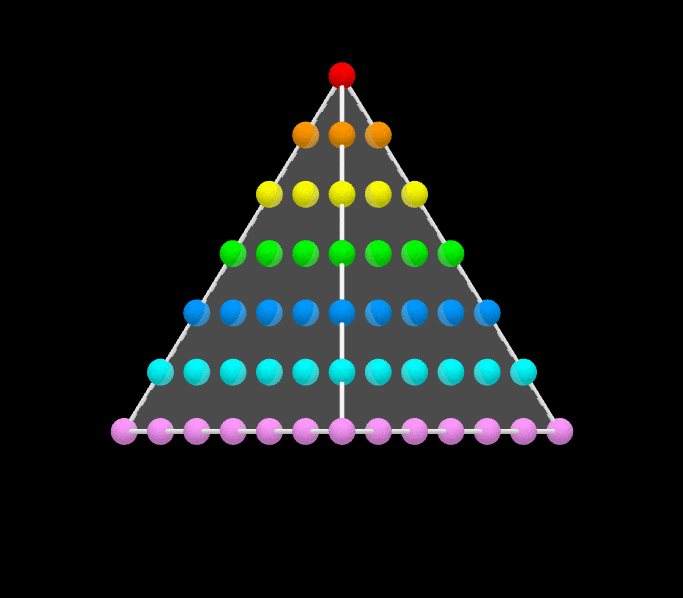
By Vincent Pantaloni, a wordless proof that the sum of the first n odd integers is n2.

By Vincent Pantaloni, a wordless proof that the sum of the first n odd integers is n2.
The 1937 phrasebook Collins’ Pocket Interpreters: France paints an alarming picture of a typical visit to France:
I cannot open my case.
I have lost my keys.
I did not know that I had to pay.
I cannot find my porter.
Excuse me, sir, that seat is mine.
I cannot find my ticket!
I have left my gloves (my purse) in the dining car.
I feel sick.
The noise is terrible.
Did you not get my letter?
I cannot sleep at night, there is so much noise.
There are no towels here.
The sheets on this bed are damp.
I have seen a mouse in the room.
These shoes are not mine.
The radiator doesn’t work.
This is not clean, bring me another.
I can’t eat this. Take it away!
The water is too hot, you are scalding me!
It doesn’t work.
This doesn’t smell very nice.
There is a mistake in the bill.
I am lost.
Someone robbed me.
I shall call a policeman.
That man is following me everywhere.
There has been an accident!
She has been run over.
He is losing blood.
He has lost consciousness.
James Thurber, who came upon the book in a London bookshop, described it as a “melancholy narrative poem” and “a dramatic tragedy of an overwhelming and original kind.” “I have come across a number of these helps-for-travelers,” he wrote, “but none has the heavy impact, the dark, cumulative power of Collins’. … The volume contains three times as many expressions to use when one is in trouble as when everything is going all right.”
I can’t find the 1937 edition that Thurber describes, but this seems to be a 1962 update.
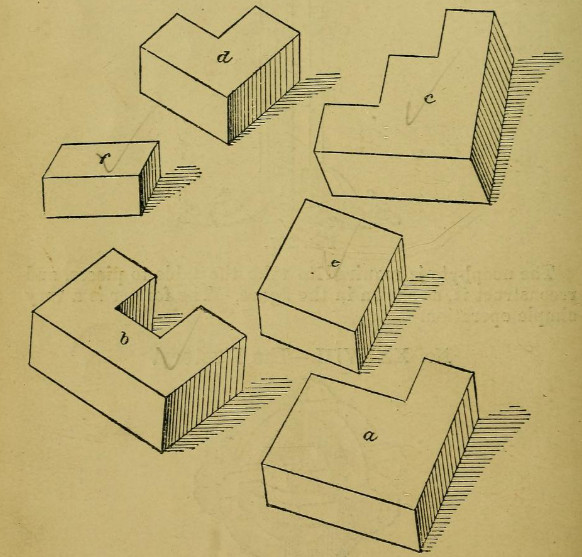
This is believed to be the oldest puzzle of its type, offered by Angelo Lewis in 1893.
“Of these six segments the experimenter is required to form a cube.”
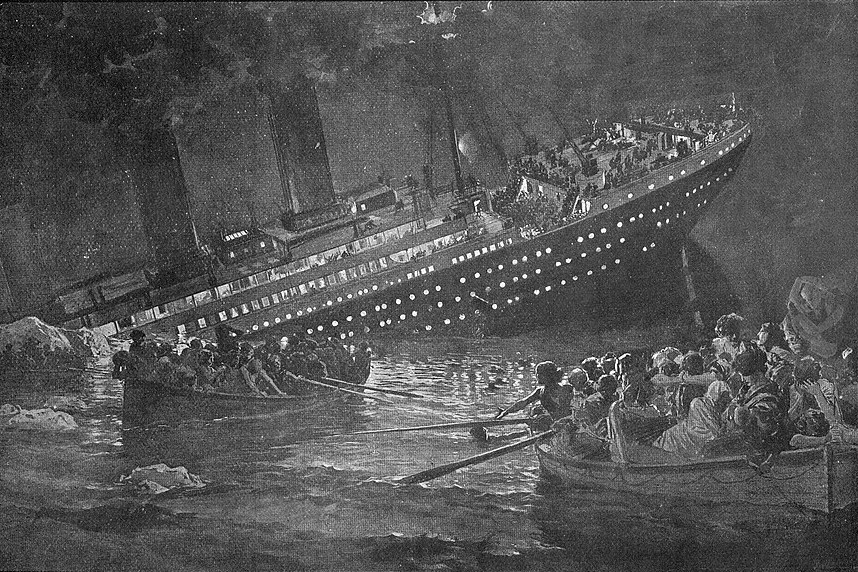
crastin
n. the day after, the morrow
festinate
adj. hurried
hammajang
adj. in a disorderly or chaotic state
disceptation
n. disputation, debate, discussion
What time did various incidents happen? Everyone agrees that the Titanic hit the iceberg at 11:40 p.m. and sank at 2:20 a.m. — but there’s disagreement on nearly everything that happened in between. … There was simply too much pressure. Mrs. Louis M. Ogden, passenger on the Carpathia, offers a good example. At one point, while helping some survivors get settled, she paused long enough to ask her husband the time. Mr. Ogden’s watch had stopped, but he guessed it was 4:30 p.m. Actually, it was only 9:30 in the morning. They were both so engrossed, they had lost all track of time.
— Walter Lord, A Night to Remember, 1955
“A planet doesn’t explode of itself,” said drily
The Martian astronomer, gazing off into the air —
“That they were able to do it is proof that highly
Intelligent beings must have been living there.”
— John Hall Wheelock
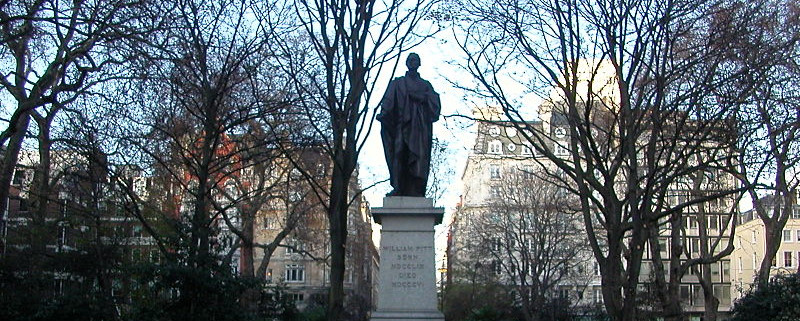
Sydney Smith suggested this inscription for William Pitt’s statue in Hanover Square:
To the Right Honourable William Pitt
Whose errors in foreign policy
And lavish expenditure of our Resources at home
Have laid the foundation of National Bankruptcy
And scattered the seeds of Revolution,
This Monument was erected
By many weak men, who mistook his eloquence for wisdom
And his insolence for magnanimity,
By many unworthy men whom he had ennobled,
And by many base men, whom he had enriched at the Public Expense.
But for Englishmen
This Statue raised from such motives
Has not been erected in vain.
They learn from it those dreadful abuses
Which exist under the mockery
Of a free Representation,
And feel the deep necessity
Of a great and efficient Reform.
“He was one of the most luminous, eloquent blunderers with which any people was ever afflicted,” Smith wrote. “God send us a stammerer; a tongueless man.”
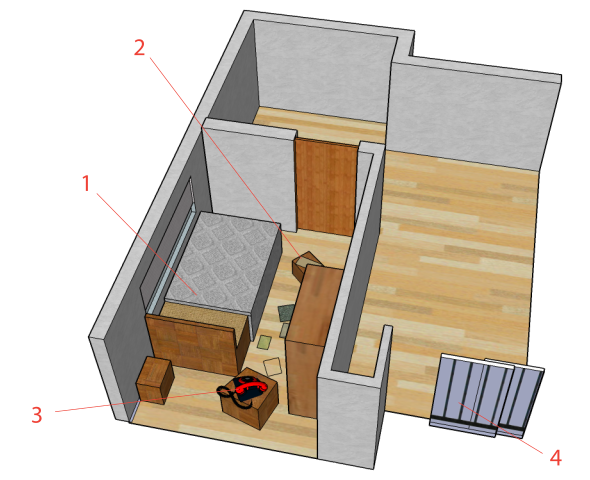
When Japanese authorities sought to honor Tokyo’s oldest man in 2010, they were rebuffed repeatedly by his family. When police finally broke into the house, they found Sogen Kato’s mummified corpse in a first-floor bedroom (1), together with a newspaper from 1978 (2) and a rotary telephone (3). An official said, “His family must have known he has been dead all these years and acted as if nothing happened. It’s so eerie.”
Kato’s granddaughter told a friend, “My grandfather shut himself in a room on the first floor of our home 32 years ago, and we couldn’t open the door from the outside. My mother said, ‘Leave him in there,’ and he was left as he was. I think he’s dead.”
Another granddaughter was eventually convicted of fraud for accepting the dead man’s pension payments. “The defendant committed a malicious crime with the selfish motive of securing revenue for her family,” the judge said in suspending the 2.5-year sentence. “However, she has paid back the pension benefits and expressed remorse for the crime.”
In 1620, the Grand Duke of Tuscany wrote to Galileo with a puzzling problem. In rolling three fair six-sided dice, it would seem that the sums 9 and 10 should appear with equal frequency, as there are six ways to produce each result:
10 = 6 + 3 + 1 = 6 + 2 + 2 = 5 + 4 + 1 = 5 + 3 + 2 = 4 + 4 + 2 = 4 + 3 + 3
9 = 6 + 2 + 1 = 5 + 3 + 1 = 5 + 2 + 2 = 4 + 4 + 1 = 4 + 3 + 2 = 3 + 3 + 3
But the duke had noticed that in practice 10 appears somewhat more often than 9. Why is this?
Galileo considered the problem and put his finger on the reason. What is it?
A striking passage from Avrahm Yarmolinsky’s 1959 biography of Ivan Turgenev:
By the end of May [1840] the traveler was back in Berlin. Before he reached the capital he touched at Leghorn, Pisa, Genoa, sailed on Lago Maggiore, traveled to St. Gotthard in a sleigh, visited Lucerne, Basel, Mannheim, Mainz, Frankfort and Leipzig, all within thirteen days. In the same period he managed to lose an umbrella, a cloak, a box, a walking stick, an opera glass, a hat, a pillow, a pen knife, a purse, three towels, two neckerchiefs, two shirts, and, for a short time, his heart.
He had entered a brief affair with Mikhail Bakunin’s sister Tatyana, but passed just as quickly out of it. “I never loved any woman more than you,” he wrote her, “though I don’t love even you with a complete and steadfast love.”
Next year’s date, 2025, is remarkable:
When asked his age, Augustus De Morgan used to say, “I was x years of age in the year x2.” (He was 43 in 1849.) People born in 1980 will be able to make the same cryptic response starting next year.
(Thanks to readers Chris Smith, Sam Householder, and Jim Howell.)